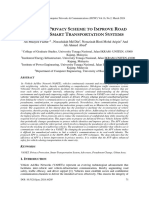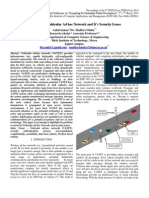N Ncryption Lgorithm To Evaluate Performance of V V Communication in Vanet
N Ncryption Lgorithm To Evaluate Performance of V V Communication in Vanet
Uploaded by
ijcisjournalCopyright:
Available Formats
N Ncryption Lgorithm To Evaluate Performance of V V Communication in Vanet
N Ncryption Lgorithm To Evaluate Performance of V V Communication in Vanet
Uploaded by
ijcisjournalOriginal Description:
Original Title
Copyright
Available Formats
Share this document
Did you find this document useful?
Is this content inappropriate?
Copyright:
Available Formats
N Ncryption Lgorithm To Evaluate Performance of V V Communication in Vanet
N Ncryption Lgorithm To Evaluate Performance of V V Communication in Vanet
Uploaded by
ijcisjournalCopyright:
Available Formats
International Journal on Cryptography and Information Security (IJCIS), Vol.3, No.
2, June 2013
AN ENCRYPTION ALGORITHM TO EVALUATE PERFORMANCE OF V2V COMMUNICATION IN VANET
Manpreet Kaur1, Rajni2 and Parminder Singh3
1
Department of Electronics & Communication, Research Scholar, S.B.S.S.T.C, Ferozepur
er_rimpi@rediffmail.com
2 3
Assistant Professor, S.B.S.S.T.C, Ferozepur
rajni_c123@yahoo.co.in Singh.parminder06@gmail.com
Senior Lecturer, Chandigarh Group of Colleges, Landran
ABSTRACT
Wireless Communications are gaining more importance because they have opened new research fields by extending data networks connectivity to environments where wired solutions are difficult to install. The networks which are deployed in the areas where the needed infrastructure is not feasible to install are adhoc networks. Mobile Adhoc Networks (MANETs), in which each node acts as both data terminal and router uses wireless medium without the need of any centralized control. Vehicular Adhoc Networks (VANETs) are subset of MANETs. The successful deployment of vehicular communication requires Vehicleto-Vehicle (V2V) & Vehicleto-Infrastructure (V2I) communication with security to improve road safety and optimize road traffic. The technique used for secure communication in the presence of adversaries is known as cryptography. Cryptography refers to encryption in which a plaintext message is converted into a ciphertext and this can be done with private-key or public-key. In this paper, an algorithm based on private key encryption is used to make communication possible between two people with QualNet simulator.
KEYWORDS
Mobile Adhoc Networks (MANETs), Vehicular Adhoc Networks (VANETs), Intelligent Transport System (ITS), Security, Vehicle-to-Vehicle (V2V), Vehicle to-Infrastructure (V2I).
1. INTRODUCTION
The process in which exchange of information via some transmission media takes place is known as network. VANETs are used for V2V and V2I communication considering all the aspects required by the process of cryptography. In Safety and non-safety applications of VANET, there is a requirement of V2V & V2I communication. B.Karp in 2000 [1] discussed Greedy Perimeter Stateless Routing (GPSR) scheme in which the default packet forwarding strategy is the greedy strategy, where the sender selects the closest vehicle to the destination as the next hop. If the sender cannot find a forwarder based on the greedy strategy, it forwards the packet around the perimeter of the region containing itself and the destination. Giuseppe Ateniese in 2005 [2] presented a new re-encryption schemes that realizes a stronger notion of security and demonstrated the usefulness of proxy re-encryption as a method of adding access control to a secure file system. Maxim Raya in 2006 [3] described the security problems of the emerging vehicular networks and it outlined the solution architecture and several
DOI:10.5121/ijcis.2013.3202 15
International Journal on Cryptography and Information Security (IJCIS), Vol.3, No. 2, June 2013
of its components. Tim Leinmuller in 2006 [4] aimed to define a consistent & future-proof solution to the problem of V2V/V2I security by focusing on SEVECOM (Secure Vehicle Communication). Pandurang Kamat in 2006 [5] proposed a security framework for vehicular networks using Identity-Based Cryptography (IBC), that provides authentication, confidentiality, message integrity, non repudiation and pseudonymity. Xiaonan Liu in 2007 [6] described an Intelligent Transport System (ITS) which can be used under the security pattern to provide the appropriate solving measures in concern with the security issues of VANETs from some aspects. Department for Transport in 2008 [7] concluded that it had been seen from various studies that the number of lives lost in motor vehicle crashes worldwide every year is by far the highest among all the categories of accidental deaths. P.Caballero-Gil in 2009 [8] analyzed the features of inter-vehicle and vehicle-to-roadside communications to propose differentiated services for node authentication, according to privacy and efficiency needs. Zuowen in 2010 [9] proposed an improved privacy-preserving mutual authentication protocol for vehicle ad hoc networks by using secure identity-based group blind signature, the private encryption system and the public encryption system. Surabhi Mahajan in 2010 [10] discussed a comparison between the two schemes that are used to reduce the overhead in authentication, when roaming proxy re-encryption scheme and new proxy re encryption scheme. Hatem Hamad in 2010 [11] proposed a new method of message security by using the coordinates in GPS (Global Positioning System) service. Sandhaya Kohli, Bandanjot Kaur in 2010 [12] discussed that vehicular adhoc networks are subclass of mobile adhoc networks which provides a distinguish approach for intelligent transport system (ITS). The survey of routing protocols in VANET is important and necessary issue for smart ITS. The proposed work discusses the advantages and disadvantages of these routing protocols. Umar Farooq Minhas in 2011 [13] described an important methodology required to enable effective V2V communication via intelligent agents. Nizar Alsharif in 2011 [14] explained that the reliability of position-based routing (PBR) in VANETs is ensured by proposing a set of plausibility checks that can mitigate the impact of PBR attacks without extra hardware requirement.
2. SECURITY CHALLENGES
The necessities required to provide security in VANETs are: 1. Authentication: An authentication framework is necessary to identify and ensure that the participants are whom they claim to be to operate securely in VANETs. 2. Integrity: Integrity is required between two communicating nodes to protect data accuracy which is main security issue desirable in VANETs. 3. Confidentiality: The challenge to protect data content from the adversaries is confidentiality. 4. Non-Repudiation: Non-Repudiation refers to somebody who possesses the private key corresponding to the signing certificate with reasonable certainity but if the key is not properly safeguarded by the original owner, a major concern can be digital forgery. 5. Pseudonymity: Pseudonomity is the state of describing a disguised identity. A holder that is one or more human beings are identified but dont disclose their true name s. 6. Privacy: The protection of personal information of drivers within the network from other nodes but extracted by authorities in case of accidents is a major privacy issue which is desirable for VANETs. 7. Scalability: The ability of a network to handle growing amount of work in a capable manner securely is Scalability, which is the main challenge in VANETs.
16
International Journal on Cryptography and Information Security (IJCIS), Vol.3, No. 2, June 2013
8. Mobility: The nodes communicating in VANETs constantly change their locations with different directions and speeds making the network dynamic in nature. So, in order to make communication successful, it is challenging to establish security protocols. 9. Key-Management: The key is used to encrypt and decrypt information during communication process. When designing security protocols for networks like VANET, the issue of key management must be resolved. 10. Location-verification: This is necessary to prevent many attacks and is helpful in data validation process. Thus to improve the security of VANETs, a solid method is required to verify the nodes positions.
3. SCENARIO USED
The choice of algorithm should be dictated by the purpose of the encryption when encryption is implemented. Private Key encryption is used because it is faster than public key encryption. However, private key encryption does not provide for digital signatures or the signing of information. It is also important to choose well-known and well-reviewed algorithms. Such algorithms are less likely to include back doors that may compromise the information being protected. The security policy should define acceptable encryption algorithms for use within the VANET System. The security policy should also specify the required procedures for key management. In order to successfully gain access to the information transmitted over the VANET, an attacker must capture the entire session and use a substantial amount of computer power and time to bruteforce the key and decrypt the traffic. Unless the information is extremely valuable, any wellknown, strong algorithm is appropriate for use in the VANET System.
Figure 1. V2V Communication in VANET
4. ALGORITHM DESCRIPTION
The Algorithm implemented here in VANET system in a straight road is Private Key Encryption in which i and j remain secret. Vehicles V1 and V2 are assumed so as to communicate securely and thus need to agree on an encryption key. 1. 2. 3. 4. 5. 6. V1 and V2 agree on two large integers a and b such that 1 < a < b. V1 then chooses a random number i and computes I = ai mod b. V1 sends I to V2. V2 then chooses a random number j and computes J = aj mod b. V2 sends J to V1. V1 computes k1 = Ji mod b. V2 computes k2 = Ij mod b. We have k1 = k2 = aij mod b and thus k1 and k2 are the secret keys to use for the other transmission.
17
International Journal on Cryptography and Information Security (IJCIS), Vol.3, No. 2, June 2013
5. IMPLEMENTATION TOOL
The performance results have been evaluated using QualNet Simulator. QualNet is network evaluation software, which is written purely in C++ and is entirely modeled as Finite State Machine (FSM). It can run on a variety of operating systems like UNIX, Windows, MAC and Linux. It is equipped with an extensive range of libraries for simulating a variety of networks. The architecture of QualNet comprises of Application, Transport, Medium Access Control (MAC), Physical layer. A unique capability for accurate, efficient simulation of large-scale, heterogeneous networks can be provided by the features of QualNet. A robust set of wired and wireless networks can be simulated by QualNet. ITM (Irregular Terrain Model) can be supported with the QualNet. QualNet executes scenarios 5-10x times faster than commercial alternatives.
6. RESULTS AND DISCUSSIONS
In this paper, the different results have been evaluated using QualNet simulator. The results shown indicate that the packet is sent between sender and receiver by using private key encryption algorithm. This means the same key is used for encryption and decryption. This leads to increase in throughput with reduce delay.
Figure 2. First packet received during transmission.
From the figure 2, we have measured the throughput of moving Vehicles communicating with each other via Access Point (A.P) already shown in figure 1. V1 Communicates with V2 via Access Point which leads to the calculation of the throughput of V1. From the Figure1, when the communication starts between AP and V2 then the throughput of first packet is calculated at its arrival. The first packet arrives from V1 having Node ID 1=2.8 seconds. The simulation carried from the help of QualNet Simulator and the length of Packet = 1024 Bytes. From the Figure 3, the throughput of Last Packet received by the AP from V1 (called Source Node) =100 Seconds approximately is calculated. After the Packet is received, the Vehicle Node sends the termination signal to do end of communication between two Vehicles with the Base Station (AP) Node.
18
International Journal on Cryptography and Information Security (IJCIS), Vol.3, No. 2, June 2013
Figure 3. Last packet received during transmission.
Figure 4. Throughput observed during transmission (with private key).
The figure 4 represents the Throughput of Two Nodes with AP by applying Security Algorithm and also calculates the speed at which the two vehicles move when sharing the data. The speed at which the Vehicles move was 60m/s with a packet size of 1024 Bytes and approximately calculated value was 4200bits/s.
19
International Journal on Cryptography and Information Security (IJCIS), Vol.3, No. 2, June 2013
Figure 5. Average End-to-End Delay during transmission (with private key).
The average end-to-end delay in a VANET means that the source node (V1) sends packet to destination Node (V2) and total average time to reach the packet to destination Node. In this Figure 5 the total average time was 0.007 seconds approximately. This delay was due to retransmission and applying security Algorithm at 802.11 networks.
Figure 6. Signals transmitted between node to node.
The signal transmission in between node to node or vehicle to vehicle has been shown in the Figure 6.This has been shown that each node sends packet to the other node and the sequence number updates. This way the vehicles communicate at the transport layer when the transmission starts between both ends.
20
International Journal on Cryptography and Information Security (IJCIS), Vol.3, No. 2, June 2013
7. CONCLUSION
Security measures guarantees that the transmissions of data are authentic that is data is accessible only by authorized parties. The security techniques can be applied to vehicular users in Vehicular Adhoc Networks. The algorithm used in the paper is private key encryption in which sender and receiver communicate securely with the help of encryption key. The algorithm reduces delay, increases throughput, provides authentication and higher security level in VANETs.
8. FUTURE WORK
The solution of the security problems is discussed (by the use of algorithm) that are encountered in VANET. The performances of data transmission in VANETs can be tested by applying more encryption algorithms to provide more security with increased throughput and reduced delay.
REFERENCES
[1] [2] Karp B, Kung H T (2000) GPRS: Greedy Perimeter Stateless Routing for wireless networks. Proc 6th Annual Int Conf on Mob Computing and Netw: 243-254. Ateniese G, Fu K, Green M, Hohenberger S (2005) Improved Proxy Re-Encryption Schemes with Applications to Secure Distributed Storage. Proc of the 12th Annual Netw and Distributed Syst Security Symp: 29-44. Raya M, Papadimitratos P, Hubaux J P (2006) Securing Vehicular Networks. J IEEE wirel commun. Leinmuller T, Buttyan L et al (2006) SEVECOM-Secure Vehicle Communication. Proc of IST Mob Summit. Kamat P, Baliga A, Trappe W (2006) An Identity-Based Security Framework for VANETs. Proc of the 3rd Int workshop on Vehicular adhoc netw: 94-95. Liu X, Fang Z, Shi L (2007) Securing Vehicular Ad Hoc netw.IEEE. Department for Transport (2008) Reported road casualties Great Britain: 2008 Annual Report. Road Casualties G. B. UK. Caballero-Gil P, Hernandez-Goya C, Fuster-Sabater A (2009) Differentiated Services to Provide Efficient Node Authentication in VANETs. Zuowen, Tan (2010) A Privacy-Preserving Mutual Authentication Protocol for Vehicle Ad Hoc Networks. J of Convergence Inf Technology. Mahajan S, Jindal A (2010) Security and Privacy in VANET to reduce Authentiation Overhead for Rapid Roaming Networks.Int J of Comput Applications. Hamad H, Elkourd S (2010) Data Encryption using the dynamic location and speed of mobile node. J Media and Commun Stud: 067-075. Sandhaya, Bandanjot ", A comparative Study of Routing Protocols in VANET", ISCET 10, pp.173 Minhas U F et al (2011) A Multifaceted Approach to Modeling Agent Trust for Effective Communication in the Application of Mobile Ad Hoc Vehicular Networks. IEEE:407-20. Alsharif N, Wasef, Shen X (2011) Mitigating the effects of Position-Based Routing Attacks in Vehicular Ad Hoc Networks. IEEE ICC Proc.
[3] [4] [5] [6] [7] [8] [9] [10] [11] [12] [13] [14]
21
International Journal on Cryptography and Information Security (IJCIS), Vol.3, No. 2, June 2013
AUTHORS
MANPREET KAUR is B.Tech in Electronics & Communication Engineering (2009) from AIET, India. She is pursuing M.Tech in Electronics & Communication Engineering from SBSSTC, India. Her research interests are Wireless, Networks, Adhoc Networks, etc. Ms. Rajni is currently Assistant Professor at SBSSTC, Punjab, India. She has completed her M.E. from NITTTR, Chandigarh, India, B.Tech from NIT, Kurukshetra, India. Ms. Rajni has about fourteen years of academic experience. She has authored a number of research papers in national, international conferences and reputed journals. Her areas of interest includes Wireless communication, and Antenna design . Parminder Singh is B.Tech in Information Technology (2006) from Punjab Technical University, India. He has done M.Tech in computer science and Engineering from Punjab Technical University, India. His research interests are TCP/IP, Wireless, Networks issues, etc.
22
You might also like
- Electronic Commerce 10th Edition Gary P Schneider PDFDocument4 pagesElectronic Commerce 10th Edition Gary P Schneider PDFJulius E. Catipon0% (3)
- Assigment UTS Pak PunangDocument2 pagesAssigment UTS Pak PunangImamMukhriNo ratings yet
- Software Engineering For Machine Learning: A Case StudyDocument10 pagesSoftware Engineering For Machine Learning: A Case StudyAzurelysiumNo ratings yet
- Secure Message Communication Using Digital Signatures and Attribute Based Cryptographic Method in VANETDocument4 pagesSecure Message Communication Using Digital Signatures and Attribute Based Cryptographic Method in VANETsandhyaNo ratings yet
- Decentralized and Scalable Privacy-Preserving Authentication Scheme in VanetsDocument9 pagesDecentralized and Scalable Privacy-Preserving Authentication Scheme in VanetsJackson SunnyNo ratings yet
- V2I2027Document6 pagesV2I2027editor_ijarcsseNo ratings yet
- Collaborative Trust-Based Secure Routing Against Colluding Malicious Nodes in Multi-Hop Ad Hoc NetworksDocument8 pagesCollaborative Trust-Based Secure Routing Against Colluding Malicious Nodes in Multi-Hop Ad Hoc Networkssuchi87No ratings yet
- A Contribution To Secure The Routing Protocol "Greedy Perimeter Stateless Routing'' Using A Symmetric Signaturebased Aes and MD5 HashDocument9 pagesA Contribution To Secure The Routing Protocol "Greedy Perimeter Stateless Routing'' Using A Symmetric Signaturebased Aes and MD5 HashijdpsNo ratings yet
- Chapter FourDocument6 pagesChapter Fouruthmannazir2627No ratings yet
- Design of Secure Chatting Application With End To End Encryption For Android PlatformDocument6 pagesDesign of Secure Chatting Application With End To End Encryption For Android Platformldsc.snf22No ratings yet
- Blockchain-Based Secure and Scalable Routing Mechanisms For VANETs ApplicationsDocument20 pagesBlockchain-Based Secure and Scalable Routing Mechanisms For VANETs ApplicationsAIRCC - IJCNCNo ratings yet
- Blockchain-Based Secure and Scalable Routing Mechanisms For Vanets ApplicationsDocument20 pagesBlockchain-Based Secure and Scalable Routing Mechanisms For Vanets ApplicationsAIRCC - IJCNCNo ratings yet
- A Secure Mutual Authentication Protocol Based On Visual Cryptography Technique For IoT-CloudDocument15 pagesA Secure Mutual Authentication Protocol Based On Visual Cryptography Technique For IoT-CloudPRANAY G (RA2111030010115)No ratings yet
- A Brief Review On Mobile Agent Security in Peer-To-peer NetworkDocument18 pagesA Brief Review On Mobile Agent Security in Peer-To-peer NetworkrohitNo ratings yet
- Identity Based Cryptography.Document7 pagesIdentity Based Cryptography.Banana KillaNo ratings yet
- 19mis0289-Ism Da 1Document13 pages19mis0289-Ism Da 1NIDISH ANANDNo ratings yet
- Security MechanismDocument9 pagesSecurity MechanismmiradorNo ratings yet
- Machine Learning-Based Intrusion Detection System Through WPA3 Protocol in Smart Contract SystemDocument17 pagesMachine Learning-Based Intrusion Detection System Through WPA3 Protocol in Smart Contract SystemInternational Journal of Innovative Science and Research TechnologyNo ratings yet
- One Time Secret Key Mechanism For Mobile CommunicationDocument9 pagesOne Time Secret Key Mechanism For Mobile CommunicationijcsesNo ratings yet
- International Journal of Engineering Research and Development (IJERD)Document13 pagesInternational Journal of Engineering Research and Development (IJERD)IJERDNo ratings yet
- Availability Aspects Through Optimization Techniques Based Outlier Detection Mechanism in Wireless and Mobile NetworksDocument20 pagesAvailability Aspects Through Optimization Techniques Based Outlier Detection Mechanism in Wireless and Mobile NetworksAIRCC - IJCNCNo ratings yet
- Assignment - IoT (MOD-5) Priyanka SinghDocument5 pagesAssignment - IoT (MOD-5) Priyanka SinghSayak MallickNo ratings yet
- Key Distillation Process On Quantum Cryptography Protocols in Network SecurityDocument6 pagesKey Distillation Process On Quantum Cryptography Protocols in Network Securityeditor_ijarcsseNo ratings yet
- Infrastructure To Vehicle Real Time Secured Communication: Ms - Smita Narendra Pathak, Prof - Urmila ShrawankarDocument5 pagesInfrastructure To Vehicle Real Time Secured Communication: Ms - Smita Narendra Pathak, Prof - Urmila ShrawankarChennamsetyNo ratings yet
- A Comparative Study On Various Message Authentication Schemes in Vehicular NetworksDocument4 pagesA Comparative Study On Various Message Authentication Schemes in Vehicular NetworkssandhyaNo ratings yet
- Al Mekhlafi, 2021Document14 pagesAl Mekhlafi, 2021Faisal AliNo ratings yet
- IEEE Projects 2012-2013 Network SecurityDocument7 pagesIEEE Projects 2012-2013 Network Securitysathish20059No ratings yet
- Intrusion Detection System For CloudDocument8 pagesIntrusion Detection System For CloudInternational Journal of Application or Innovation in Engineering & ManagementNo ratings yet
- Wireless Sensor Network Security Model Using Zero Knowledge ProtocolDocument5 pagesWireless Sensor Network Security Model Using Zero Knowledge ProtocolIOSRJEN : hard copy, certificates, Call for Papers 2013, publishing of journalNo ratings yet
- Enhancement in Elimination of Security Threads Using Trusted Proactive RoutingDocument7 pagesEnhancement in Elimination of Security Threads Using Trusted Proactive RoutingInternational Organization of Scientific Research (IOSR)No ratings yet
- General Introduction: Chapter OneDocument67 pagesGeneral Introduction: Chapter OneDamilNo ratings yet
- Secured Data Transmission Method For Van NetworksDocument4 pagesSecured Data Transmission Method For Van NetworksIJSTENo ratings yet
- Advanced Privacy Scheme To Improve Road Safety in Smart Transportation SystemsDocument16 pagesAdvanced Privacy Scheme To Improve Road Safety in Smart Transportation Systemsijcncjournal019No ratings yet
- Mathematics 11 00399Document17 pagesMathematics 11 00399felipeandres.marquezmNo ratings yet
- Secure and Efficient Key Management in Mobile Ad Hoc NetworksDocument19 pagesSecure and Efficient Key Management in Mobile Ad Hoc NetworksالطيبحمودهNo ratings yet
- 2 Sensors-21-04884Document18 pages2 Sensors-21-04884Taimour KhanNo ratings yet
- Proceedings of Spie: Svchecker: A Deep Learning-Based System For Smart Contract Vulnerability DetectionDocument7 pagesProceedings of Spie: Svchecker: A Deep Learning-Based System For Smart Contract Vulnerability Detectionnofeh84660No ratings yet
- Overview On Vehicular Ad Hoc Network and It's Security IssuesDocument6 pagesOverview On Vehicular Ad Hoc Network and It's Security IssuesAnkit KomarNo ratings yet
- 19148-Article Text-78917-2-10-20240405Document24 pages19148-Article Text-78917-2-10-20240405Mangayarkarasi RNo ratings yet
- VANET Security Against Sybil Attack by Using New SRAN Routing ProtocolDocument5 pagesVANET Security Against Sybil Attack by Using New SRAN Routing ProtocolATSNo ratings yet
- 1 s2.0 S014036642400080X MainDocument18 pages1 s2.0 S014036642400080X MainPRANAY G (RA2111030010115)No ratings yet
- Internship ReportDocument13 pagesInternship Reportlajuvanthi mNo ratings yet
- HafizulDocument40 pagesHafizulSamrat AshishNo ratings yet
- New Identity Batch Verification Privacy Scheme in VANETDocument5 pagesNew Identity Batch Verification Privacy Scheme in VANETIJANANo ratings yet
- Method Study of Security Patrol Guards System Based On QR Code and Mobile Cloud Computing (Case Study)Document15 pagesMethod Study of Security Patrol Guards System Based On QR Code and Mobile Cloud Computing (Case Study)metryNo ratings yet
- A Protective Mechanism To Avoid Eavesdropping Attack in MANETDocument6 pagesA Protective Mechanism To Avoid Eavesdropping Attack in MANETEditor IJRITCCNo ratings yet
- Virtual Private Network A Veritable Tool For Network SecurityDocument4 pagesVirtual Private Network A Veritable Tool For Network SecurityInternational Journal of Research in Engineering and TechnologyNo ratings yet
- A Review of Hash Function Types and Their ApplicationDocument14 pagesA Review of Hash Function Types and Their ApplicationMohitNo ratings yet
- TEAM: Trust-Extended Authentication Mechanism For Vehicular Ad Hoc NetworksDocument4 pagesTEAM: Trust-Extended Authentication Mechanism For Vehicular Ad Hoc NetworksRaghavendra Prasad ReddyNo ratings yet
- A Hybrid Approach Using Digital ForensicDocument11 pagesA Hybrid Approach Using Digital ForensicImen SaidiNo ratings yet
- Quantum-Resistant Cryptography For The Internet of Things Based On Location-Based LatticesDocument19 pagesQuantum-Resistant Cryptography For The Internet of Things Based On Location-Based Lattices2K20CO158 Eshan DevNo ratings yet
- IJCER (WWW - Ijceronline.com) International Journal of Computational Engineering ResearchDocument6 pagesIJCER (WWW - Ijceronline.com) International Journal of Computational Engineering ResearchInternational Journal of computational Engineering research (IJCER)No ratings yet
- Quantum Inspired Security On A Mobile Phone: Abstract. The Widespread Use of Mobile Electronic Devices Increases The ComDocument16 pagesQuantum Inspired Security On A Mobile Phone: Abstract. The Widespread Use of Mobile Electronic Devices Increases The Comwafa bourasNo ratings yet
- Secuirty Issue in Mobile CommunicationDocument6 pagesSecuirty Issue in Mobile CommunicationMunish KharbNo ratings yet
- (IJCST-V12I5P8) :sanjit Mazumder, Soumi Mondal Bera, Atikul IslamDocument7 pages(IJCST-V12I5P8) :sanjit Mazumder, Soumi Mondal Bera, Atikul Islameditor1ijcstNo ratings yet
- An Efficient Routing Protocol For Mobile Ad Hoc Network For Secured Communication and Minimized Power ConsumptionDocument8 pagesAn Efficient Routing Protocol For Mobile Ad Hoc Network For Secured Communication and Minimized Power ConsumptionijansjournalNo ratings yet
- A2-A Cross-Domain Group Authentication Scheme For LTE-A Based VehicularDocument5 pagesA2-A Cross-Domain Group Authentication Scheme For LTE-A Based Vehicularrmsaqib1No ratings yet
- Security in VANETDocument2 pagesSecurity in VANETnanish_aliNo ratings yet
- Part 2: Wsn/Iot Integration Part 2: Security For Wsn/Iot IntegrationDocument27 pagesPart 2: Wsn/Iot Integration Part 2: Security For Wsn/Iot IntegrationJiwa Bin AbdullahNo ratings yet
- EFFICIENT SECURITY FRAMEWORK FOR DATA MIGRATION IN A CLOUD COMPUTING ENVIRONMENTDocument9 pagesEFFICIENT SECURITY FRAMEWORK FOR DATA MIGRATION IN A CLOUD COMPUTING ENVIRONMENTJohn DoeNo ratings yet
- Seminar ReportDocument22 pagesSeminar Reportjomon eldoNo ratings yet
- Information Security of Intelligent Vehicles Communication: Overview, Perspectives, Challenges, and Possible SolutionsFrom EverandInformation Security of Intelligent Vehicles Communication: Overview, Perspectives, Challenges, and Possible SolutionsRating: 5 out of 5 stars5/5 (1)
- International Journal On Cryptography and Information Security (IJCIS)Document2 pagesInternational Journal On Cryptography and Information Security (IJCIS)ijcisjournalNo ratings yet
- International Journal On Cryptography and Information Security (IJCIS)Document2 pagesInternational Journal On Cryptography and Information Security (IJCIS)ijcisjournalNo ratings yet
- IJCISDocument2 pagesIJCISijesajournalNo ratings yet
- International Journal On Cryptography and Information Security (IJCIS)Document2 pagesInternational Journal On Cryptography and Information Security (IJCIS)ijcisjournalNo ratings yet
- International Journal On Cryptography and Information Security (IJCIS)Document2 pagesInternational Journal On Cryptography and Information Security (IJCIS)ijcisjournalNo ratings yet
- International Journal On Cryptography and Information Security (IJCIS)Document2 pagesInternational Journal On Cryptography and Information Security (IJCIS)ijcisjournalNo ratings yet
- International Journal On Cryptography and Information Security (IJCIS)Document2 pagesInternational Journal On Cryptography and Information Security (IJCIS)ijcisjournalNo ratings yet
- International Journal On Cryptography and Information Security (IJCIS)Document2 pagesInternational Journal On Cryptography and Information Security (IJCIS)ijcisjournalNo ratings yet
- Module 1 WorkbookDocument10 pagesModule 1 Workbooktempmail432165No ratings yet
- Ecdis CBT e PDFDocument2 pagesEcdis CBT e PDFSamiul100% (1)
- Admin Guide - PsDocument76 pagesAdmin Guide - PspuffffnadaNo ratings yet
- Word 2010 Interface: Tutorial-2Document5 pagesWord 2010 Interface: Tutorial-2Sabrena FennaNo ratings yet
- n04 PDFDocument29 pagesn04 PDFsanjog kshetriNo ratings yet
- Web Development Lab: Rajat Goyal 1 14IT056Document20 pagesWeb Development Lab: Rajat Goyal 1 14IT056Shiv GuptaNo ratings yet
- Full PLDocument1,278 pagesFull PLJoao FernandesNo ratings yet
- Introducing Switch Statement and For Loop: Java ProgrammingDocument22 pagesIntroducing Switch Statement and For Loop: Java ProgrammingskyyyeisthebestNo ratings yet
- Digital GraphicsDocument57 pagesDigital GraphicsSugayra Alfaro MendozaNo ratings yet
- Design of IoT Laboratory ExercisesDocument47 pagesDesign of IoT Laboratory Exercisesjpc.freelance19No ratings yet
- Panel Control SystemDocument4 pagesPanel Control SystemRirin EltamaNo ratings yet
- Porter 5 Forces of Competition For HPDocument14 pagesPorter 5 Forces of Competition For HPPeter W James Jr.No ratings yet
- PGH FC FB Fuer s7cp 76Document191 pagesPGH FC FB Fuer s7cp 76Surit ApiwanNo ratings yet
- Cpeo 450 Ds FinalDocument4 pagesCpeo 450 Ds Finalmy_scribd_docsNo ratings yet
- Oracle DBADocument5 pagesOracle DBAapi-121377012No ratings yet
- LG 55uf7600 Webos 2.0 Uhd LCD TV Main Board Info 2015-TrainingDocument6 pagesLG 55uf7600 Webos 2.0 Uhd LCD TV Main Board Info 2015-TrainingLuis Fernando Calle JaramilloNo ratings yet
- Accenture 2023 - Round1 - MCQ - Questions and AnswersDocument11 pagesAccenture 2023 - Round1 - MCQ - Questions and AnswersVH10765 SNEHA J100% (1)
- DCP Inventory SMIDocument10 pagesDCP Inventory SMIGenevenNo ratings yet
- ATS22 Modbus Address WordsDocument21 pagesATS22 Modbus Address WordsASTERIXNo ratings yet
- Profile Core Banking SolutionDocument6 pagesProfile Core Banking SolutionVairag JainNo ratings yet
- Cisco APIC 3-2 With VMware v1 Network Admin Demo GuideDocument42 pagesCisco APIC 3-2 With VMware v1 Network Admin Demo GuideMahmoud RamadanNo ratings yet
- Demystifying Tdls Focus On l22 The New Kid On The BlockDocument4 pagesDemystifying Tdls Focus On l22 The New Kid On The Blockcall2home9741No ratings yet
- Facing Tomorrow's Quantum Hackers TodayDocument23 pagesFacing Tomorrow's Quantum Hackers TodayHarsh ParikhNo ratings yet
- PhotoMechanic ManualDocument6 pagesPhotoMechanic ManualAlisha AlexanderNo ratings yet
- Epinoyload All Product List Smart TNTDocument5 pagesEpinoyload All Product List Smart TNTJohanne Rhielle OpridoNo ratings yet
- F16 Drone ContixoDocument1 pageF16 Drone ContixoDan LemNo ratings yet
- S7 300 CP343-1-Lean-CX10 76Document50 pagesS7 300 CP343-1-Lean-CX10 76Marcio Sócrates100% (1)




























































































